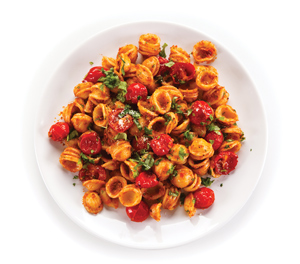Operators can choose from many different types of commercial ranges that can vary in widths, features, configurations and available options. Typically, these involve a range top and base.
 A range top is among the most used pieces of equipment in large-volume applications. While operators can use range tops for cooking, stir frying, grilling, sautéing, searing, boiling, broiling, etc., they use the base for baking, roasting, warming or storage. In addition, a growing number of operators now place refrigerated or freezer drawers beneath their ranges, giving cooks greater access to ingredients.
A range top is among the most used pieces of equipment in large-volume applications. While operators can use range tops for cooking, stir frying, grilling, sautéing, searing, boiling, broiling, etc., they use the base for baking, roasting, warming or storage. In addition, a growing number of operators now place refrigerated or freezer drawers beneath their ranges, giving cooks greater access to ingredients.
Restaurant or cafe ranges handle light-duty applications. Higher-volume operations will require heavy-duty ranges. While both have similar features, the construction of heavy-duty ranges uses sturdier materials that allow these units to stand up to higher use and heavier pots and pans. Operators can have these more substantial models configured and customized as island suites. Medium-duty ranges are typically free-standing and offered with standard and convection
oven options.
Most manufacturers construct ranges of steel or stainless steel, often 16 gauge. Some models also feature enameled surfaces for an enhanced appearance. Range grates offer welded steel or cast-iron construction.
Common varieties of ranges include open-burner, hot tops, griddle tops and graduated hot tops. Griddle tops range in size from 11 inches to 72 inches wide. Hot tops facilitate easier movement of pots on range tops. Operators can also choose a French hot plate as their top. Plancha griddles continue to grow in popularity for creating international cuisine.
A variety of specialty ranges — tabletop, stockpot, Chinese, taco — are custom models created for specific applications. Induction ranges have become increasingly popular as well, due to their energy efficiency and their potential to keep the kitchen cooler, since these units do not emit heat.
Electric and gas ranges offer different burners. Gas ranges have open burners, with Btu ranging from 20,000 to 40,000. The burner’s grate bowl design determines how efficiently it directs the Btu to the cooking vessel. Units come with anywhere from 4 to 10 burners. Electric units utilize tubular metal elements containing resistance wires. Protective hot tops or French plates cover the metal elements. Electric ranges come in 208-, 240- or 480-volt models.
Ranges are available with up to two ovens underneath. The standard width of the range top can vary from 12 up to 72 inches, usually in 12- or 18-inch increments, depending on the equipment and requirements. Most range makers market their units in 3 sizes: 24, 48 and 60 inches. Restaurant ranges typically measure 24 to 72 inches compared to heavy-duty versions, which generally measure 32 to 36 inches per section. A hotel profile range with a 32-inch base provides lots of fire power in a smaller footprint. Bakery-depth models accommodate pans both vertically and horizontally.
Many models come with 6-inch adjustable legs to ensure a level stance. The bases can be mixed and matched to fit under the chosen range top. The most popular oven size is 36 inches.
Some units feature removable components to make it easier to clean and maintain a range. The burner box can be insulated to enhance efficiency and heavy-duty baffles can help make heat flow more even. Many models come with open-top or step-up burners, a full-width or graduated hot top, and/or a full-width griddle or charbroiler. Thermostatically controlled griddles provide added temperature control and consistency. Some ranges offer a flash tube system, an energy-efficient design that includes one pilot for every two burners instead of for each one. Units are available with electronic ignition burner systems, instead of standing pilots, which also save on energy use.
Other options include a variety of shelving sizes, such as a stainless-steel tubular high shelf or double-high shelf, a salamander-broiler or
cheesemelter. A rearward-extending flue riser is also available to increase the overall depth of a range to match an existing deep cooking battery. Manufacturers also have designed burners that resist clogging.



